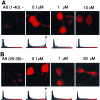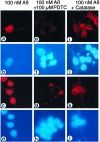Transcription factor NF-kappaB is activated in primary neurons by amyloid beta peptides and in neurons surrounding early plaques from patients with Alzheimer disease
- PMID: 9122249
- PMCID: PMC20142
- DOI: 10.1073/pnas.94.6.2642
Transcription factor NF-kappaB is activated in primary neurons by amyloid beta peptides and in neurons surrounding early plaques from patients with Alzheimer disease
Abstract
Amyloid beta peptide (A beta)-containing plaques are a hallmark of Alzheimer disease. Here, we show that the neurotoxic A beta, a major plaque component, is a potent activator of the transcription factor NF-kappaB in primary neurons. This activation required reactive oxygen intermediates as messengers because an antioxidant prevented A beta-induced NF-kappaB activation. Maximal activation of NF-kappaB was found with 0.1 microM A beta-(1-40) and 0.1 microM A beta-(25-35) fragments, making a role for NF-kappaB in neuroprotection feasible. Using an activity-specific mAb for the p65 NF-kappaB subunit, activation of NF-kappaB also was observed in neurons and astroglia of brain sections from Alzheimer disease patients. Activated NF-kappaB was restricted to cells in the close vicinity of early plaques. Our data suggest that the aberrant gene expression in diseased nervous tissue is at least in part due to A beta-induced activation of NF-kappaB, a potent immediate-early transcriptional regulator of numerous proinflammatory genes.
Figures





References
-
- Glenner G G, Wong C W. Biochem Biophys Res Commun. 1984;120:885–890. - PubMed
-
- Kang J, Lemaire H G, Unterbeck A, Salbaum M, Masters C L, Grzeschik K H, Multhaup G, Beyreuther K, Müller-Hill B. Nature (London) 1987;325:733–736. - PubMed
-
- Müller U, Cristina N, Li Z W, Wolfer D P, Lipp H P, Rulicke T, Brandner S, Aguzzi A, Weissmann C. Cell. 1994;79:755–765. - PubMed
-
- Zheng H, Jiang M, Trumbauer M E, Sirinahsinghji D J S, Hopkins R, et al. Cell. 1995;81:525–531. - PubMed
Publication types
MeSH terms
Substances
LinkOut - more resources
Full Text Sources
Other Literature Sources
Medical

